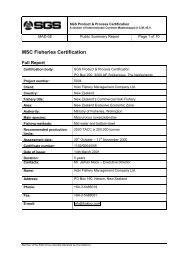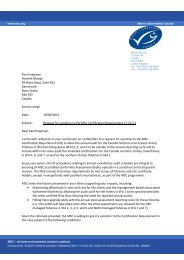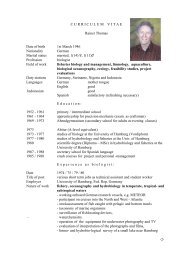SGS Product & Process Certification - Marine Stewardship Council
SGS Product & Process Certification - Marine Stewardship Council
SGS Product & Process Certification - Marine Stewardship Council
Create successful ePaper yourself
Turn your PDF publications into a flip-book with our unique Google optimized e-Paper software.
Condition 1: P1, 1.2.2 Harvest control rule (score 75).<br />
Rationale: Although technical conservation measures are in place (minimum landing size and<br />
mesh size controls) that seek to maximise yield per recruit, the HCRs that are in place do not<br />
ensure that the exploitation rate is reduced as limit reference points are approached (with<br />
respect to maximum sustainable yield, since recruitment is not stock-driven).<br />
Condition: the client should liaise with management and research bodies to determine what<br />
part they can play in the development of a harvest control rule that better ensures that the<br />
exploitation rate on North Sea bass is reduced as limit reference points are approached.<br />
Timescale: By first surveillance audit: written evidence is required of appropriate action by the<br />
client towards management authorities and research institutes, and of their response.<br />
Condition 2: P3, 3.2.1 Fishery specific objectives (score 70)<br />
Rationale: There are clearly defined management objectives for Dutch North Sea fisheries in<br />
general, but fishery-specific management objectives are not explicitly formulated for the sea<br />
bass fishery (as a whole, in the North Sea). Condition: The client should liaise with the<br />
relevant management authorities and scientists (IMARES and ICES) and encourage them to<br />
develop specific objectives for this fishery, which would preferably also account for other fishing<br />
metiers targeting sea bass, such as trawling and gill net fishing. The Client should also<br />
formulate management objectives for the sea bass fishery within the VBHL management plan.<br />
Timescale: By first surveillance audit, written evidence is required of appropriate action by<br />
client to encourage the relevant management authorities to formulate management objectives<br />
for the sea bass fishery, and to demonstrate that a management objective for the sea bass<br />
fishery is incorporated within the VBHL management<br />
Condition 3. P3, 3.2.2 Decision making process (score 70)<br />
Rationale: Management systems for Dutch North Sea fisheries are well established and<br />
generally effective, decision-making processes are well developed and fishery representatives<br />
are regularly consulted by the relevant authorities. However, the rod and line fishery for bass is<br />
a relatively small sector and is not represented by the National Fishermen‘s organisations.<br />
Condition 3:The client should encourage the relevant management authorities to include the<br />
UoC in formal decision-making processes,<br />
Timescale: By first surveillance audit, written evidence is required of appropriate action by<br />
client to encourage the relevant management authorities to develop a formal decision making<br />
process for this fishery, and of their response.<br />
By the third surveillance visit, evidence is required of the establishment of a more fisheryspecific<br />
decision making-process.<br />
Condition 4. P3, 3.2.5 Information and monitoring (score 75).<br />
Rationale: Because fishery-specific management objectives are not explicitly formulated for<br />
the rod and line sea bass fishery, there is no provision for evaluation of the fishery‘s<br />
performance against objectives.<br />
Page 6 of 151





